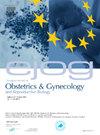Efficacy of NSAIDs in reducing pain during intrauterine device Insertion: A systematic review
IF 2.1
4区 医学
Q2 OBSTETRICS & GYNECOLOGY
European journal of obstetrics, gynecology, and reproductive biology
Pub Date : 2025-03-25
DOI:10.1016/j.ejogrb.2025.03.048
引用次数: 0
Abstract
Background
Intrauterine devices (IUD) are highly effective, but insertion pain deters many. While no consensus exists on gold standard analgesia, practitioners commonly recommend over-the-counter non-steroidal anti-inflammatory drugs (NSAIDs). This systematic review evaluates NSAID efficacy for pain reduction during IUD insertion. Methods: We searched PubMed, Embase, Web of Science, Scopus and Cochrane Library using (intrauterine device* OR IUD*) AND (NSAIDs OR non-steroidal anti-inflammatory drugs). The primary outcome was patient-reported pain during IUD insertion. The authors evaluated each publication for bias using the Centre for Evidenced-Based Medine Critical Appraisal Tool for Randomised Control Trials (CEBM). Results: The search yielded 6,529 studies, retrieving 29 full texts, with 20 meeting inclusion criteria. This review found limited evidence that prophylactic NSAIDs provide clinically significant pain relief for most women. The review included various NSAID types and dosages. Six studies demonstrated a statistically significant reduction in pain (p < 0.05) compared to placebo. Conclusion: Prophylactic NSAIDs show limited efficacy in reducing IUD insertion pain, with 70 % of studies reporting no significant benefit. These findings, suggesting lower overall effectiveness than previous research, underscore the need for standardized approaches and further research into meaningful pain relief. Heterogeneity in NSAID types, dosages, and pain assessment methods highlights the need for targeted research to improve patient-centered reproductive healthcare.
求助全文
约1分钟内获得全文
求助全文
来源期刊
CiteScore
4.60
自引率
3.80%
发文量
898
审稿时长
8.3 weeks
期刊介绍:
The European Journal of Obstetrics & Gynecology and Reproductive Biology is the leading general clinical journal covering the continent. It publishes peer reviewed original research articles, as well as a wide range of news, book reviews, biographical, historical and educational articles and a lively correspondence section. Fields covered include obstetrics, prenatal diagnosis, maternal-fetal medicine, perinatology, general gynecology, gynecologic oncology, uro-gynecology, reproductive medicine, infertility, reproductive endocrinology, sexual medicine and reproductive ethics. The European Journal of Obstetrics & Gynecology and Reproductive Biology provides a forum for scientific and clinical professional communication in obstetrics and gynecology throughout Europe and the world.

 求助内容:
求助内容: 应助结果提醒方式:
应助结果提醒方式:


